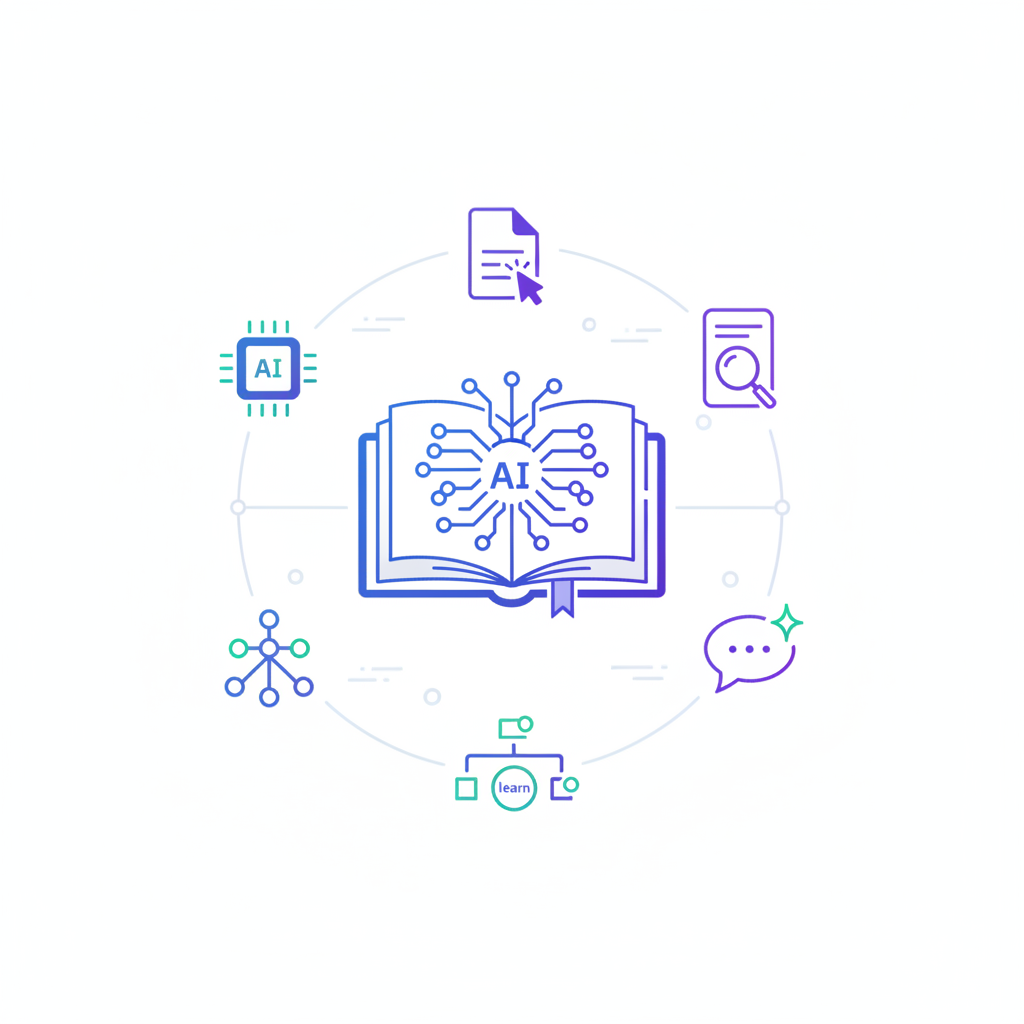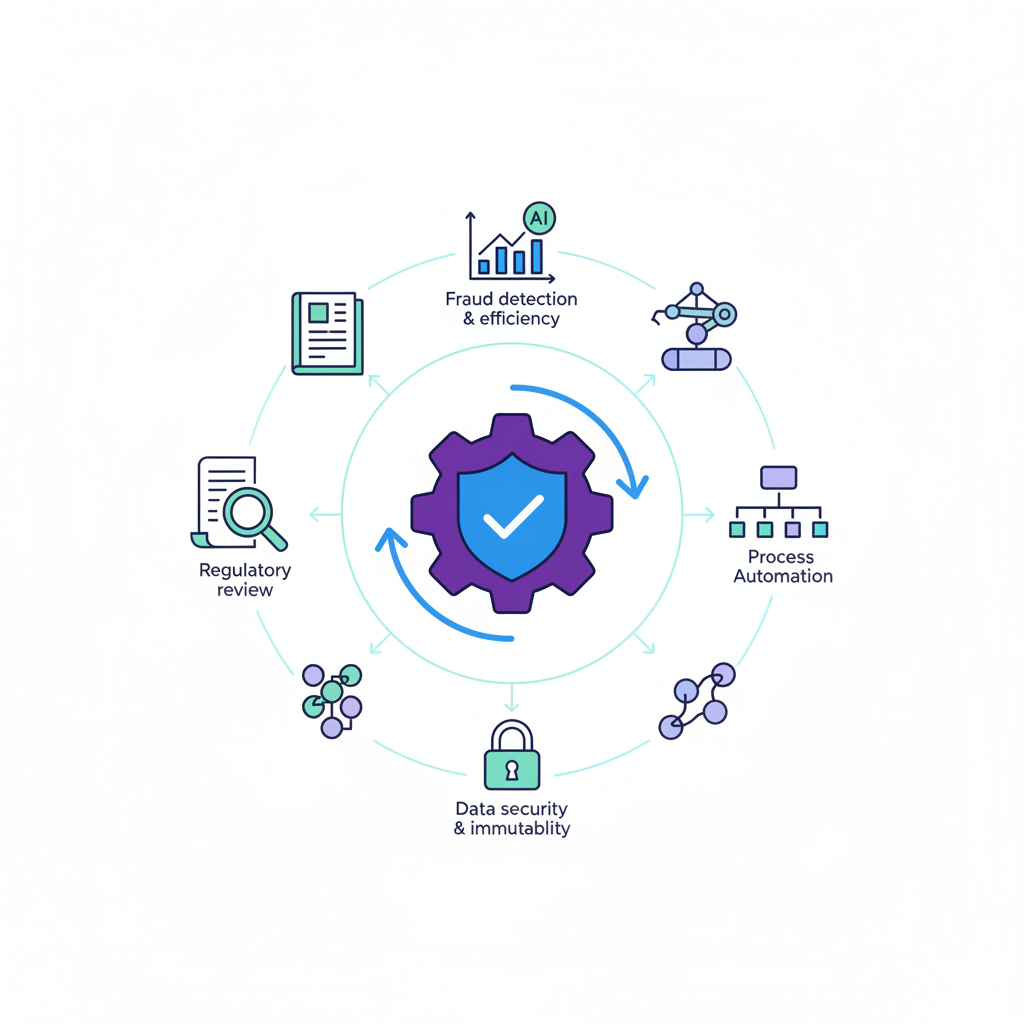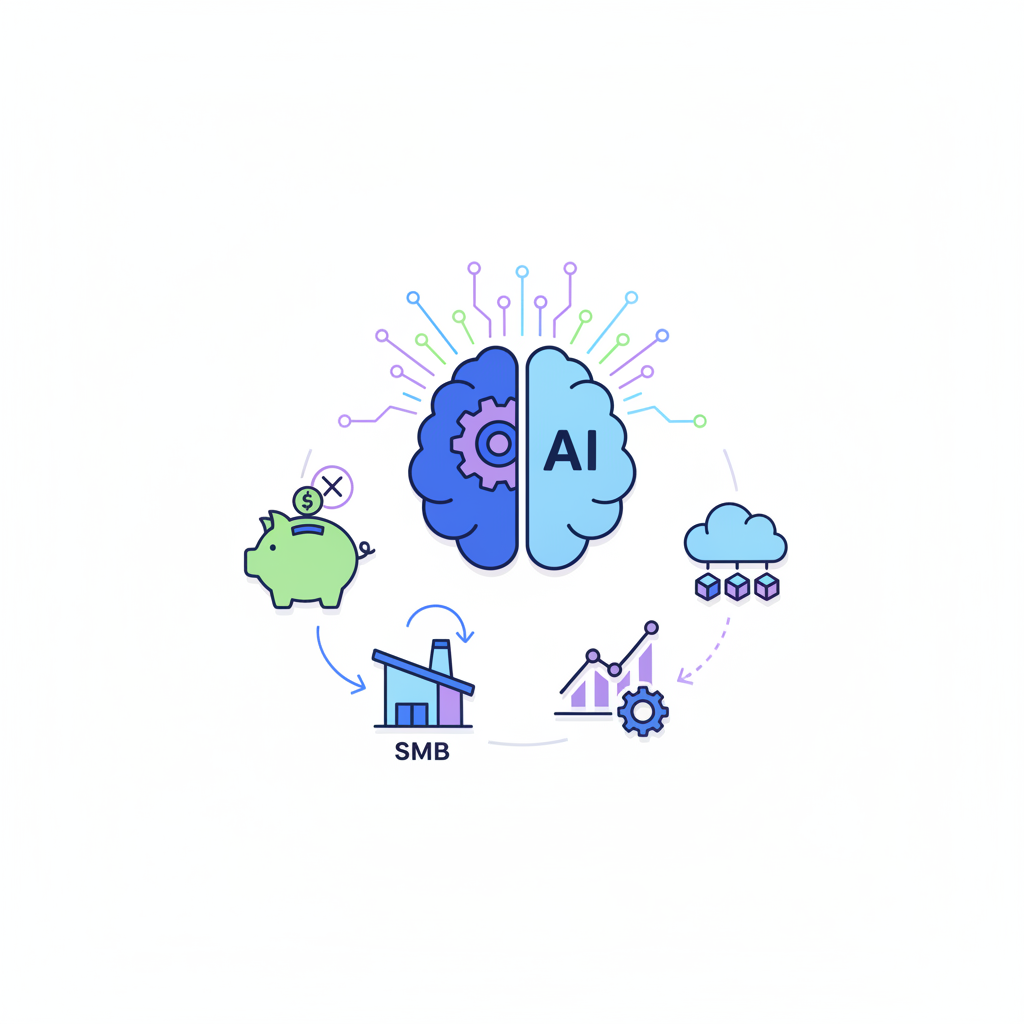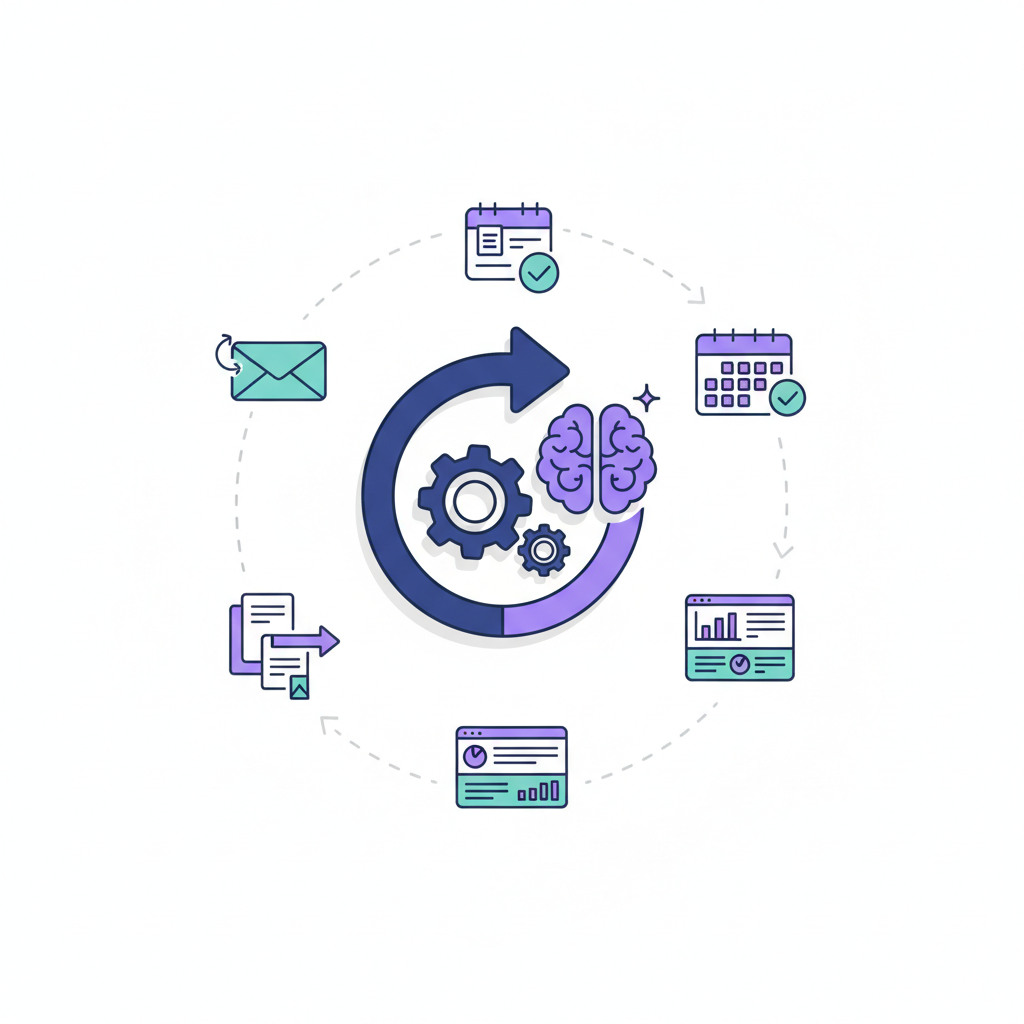The Essential AI Glossary for 2026: 50+ Key Terms You Need to Know
The rapid evolution of AI demands a clear understanding of its complex terminology. This comprehensive 'AI glossary 2026' demystifies over 50 essential terms, spanning core concepts like Supervised Learning, the difference between ANI and AGI, and the mechanics of Generative AI. It also covers critical operational terms like MLOps and Data Drift, and crucial societal concepts like AI Ethics and Data Sovereignty, equipping professionals with the language needed to navigate and succeed in the AI-driven future.

Navigating the AI Landscape: Your Essential Glossary for 2026
The world of Artificial Intelligence (AI) is evolving at an unprecedented pace, transforming industries, reshaping job roles, and redefining the very fabric of our digital existence. This rapid, often overwhelming, evolution brings with it a complex and ever-expanding lexicon of terms that can leave even seasoned professionals feeling lost. From machine learning paradigms to the nuances of generative AI, the sheer volume of new concepts and acronyms makes it challenging for professionals, enthusiasts, and decision-makers alike to keep pace with critical AI terms. Understanding this dynamic AI terminology is no longer optional; it's a prerequisite for navigating the future.
The problem statement is clear: without a solid grasp of these key AI terms, individuals and organizations risk falling behind, misinterpreting advancements, and making suboptimal strategic decisions. This is especially true as we look towards 2026, a year projected to see even more profound integration of AI across all sectors. How can you effectively plan, innovate, or even participate in discussions if the language of the AI era remains a mystery?
Our solution is this comprehensive "AI glossary 2026." Designed to be your definitive guide, it provides clear, concise, and future-oriented definitions for over 50 essential AI terms. This isn't just a list; it's a strategic resource crafted to demystify the complexities of artificial intelligence. What readers will gain from this essential AI glossary is more than just definitions. You'll acquire a master AI terminology guide, enabling a deeper understanding of practical applications, critical business implications, and the projected importance of each term in the rapidly approaching AI era. Prepare to empower yourself with the knowledge needed to thrive in an AI-driven world.
I. Core Machine Learning & Foundational AI Concepts
This section lays the groundwork for understanding the broader landscape of AI, delving into the fundamental machine learning paradigms and the different levels of AI intelligence. By focusing on clarity, real-world examples, and the foundational importance of these terms, we aim to equip you with the core knowledge necessary to grasp more advanced AI concepts as they evolve towards 2026. These building blocks are crucial for anyone seeking to truly comprehend the mechanics and potential of artificial intelligence.
A. The Building Blocks: Machine Learning Paradigms
At the heart of modern artificial intelligence lies Machine Learning (ML), a core discipline that enables systems to learn from data, identify patterns, and make decisions with minimal human intervention. Its role in AI is foundational, serving as the engine for countless intelligent applications. Within ML, three primary paradigms dominate:
- Supervised Learning: This is where an algorithm learns from a labeled dataset, meaning each input data point is paired with an output label. The model learns to map inputs to outputs, making predictions on new, unseen data. Think of it like a student learning from flashcards with answers on the back. Applications include image classification, spam detection, and predictive analytics.
- Unsupervised Learning: In contrast, unsupervised learning deals with unlabeled data. The algorithm's task is to find hidden patterns, structures, or relationships within the data on its own. It's like giving a student a pile of books and asking them to organize them into categories without any prior instructions. Clustering customer segments or anomaly detection are common uses.
- Reinforcement Learning: This paradigm involves an agent learning to make decisions by performing actions in an environment to maximize a cumulative reward. It's a trial-and-error process, much like training a pet with treats. Self-driving cars learning to navigate or AI playing complex games are prime examples.
Deep Learning is a specialized subset of machine learning that utilizes Neural Networks with multiple layers (hence "deep") to learn complex patterns from vast amounts of data. These networks are inspired by the human brain's structure and function, excelling in tasks like image recognition, natural language processing, and speech synthesis. A Model (AI) refers to the output of a machine learning algorithm after it has been trained on data. It encapsulates the learned patterns and rules. The Parameters (AI) are the internal variables of this model that are adjusted during the training process to minimize errors and improve performance. Once a model is trained, Inference (AI) is the process of using that trained model to make predictions or decisions on new, unseen data. These core AI concepts will continue to evolve, underpinning increasingly sophisticated AI systems by 2026, making their understanding paramount.
B. Understanding AI's Scope: ANI, AGI, and ASI
To truly grasp the future trajectory of AI, it's crucial to understand the distinctions between its different levels of intelligence. These classifications help us contextualize current capabilities and anticipate future advancements, forming a vital part of our AI terminology for 2026.
Artificial Narrow Intelligence (ANI), also known as Weak AI, is the only type of AI that exists today. ANI refers to AI systems designed and trained for a specific, narrow task. These systems can perform their designated function exceptionally well, often surpassing human capabilities in that particular domain, but they lack general cognitive abilities. Current examples of ANI are ubiquitous: the AI that powers your smartphone's facial recognition, the recommendation engine on streaming platforms, voice assistants like Siri or Alexa, and even the AI that beats grandmasters at chess. Each of these systems is highly specialized and cannot perform tasks outside its programmed scope. An ANI designed to play chess cannot write a novel, nor can a spam filter diagnose a medical condition.
The ongoing pursuit and significant challenge lies in achieving Artificial General Intelligence (AGI), often referred to as Strong AI or human-level AI. AGI would possess the ability to understand, learn, and apply intelligence to any intellectual task that a human being can. This includes reasoning, problem-solving, abstract thinking, and learning from experience across diverse domains, rather than being limited to a single task. The development of AGI is a monumental scientific and engineering challenge, requiring breakthroughs in areas like common sense reasoning, emotional intelligence, and self-awareness. While significant progress is being made in various sub-fields of AI, a true AGI remains largely theoretical and is not expected to be achieved by 2026, though discussions and research efforts will intensify.
Beyond AGI lies the theoretical concept of Artificial Superintelligence (ASI). ASI would be an intellect that is vastly superior to the best human brains in virtually every field, including scientific creativity, general wisdom, and social skills. The implications of ASI are profound and raise significant ethical considerations and discussions around AI ethics and AI safety. The potential for an ASI to rapidly self-improve and surpass human control is a central theme in these discussions, prompting calls for robust AI safety research and governance frameworks. By 2026, while ASI will remain firmly in the realm of theory, the ethical and safety discussions surrounding its potential will become even more prominent, making an understanding of these classifications crucial for navigating the evolving AI era.
II. The Generative AI Revolution & Language Models
This section delves into the most impactful AI advancements of recent years, focusing on the transformative power of generative AI and the sophisticated capabilities of large language models. We'll emphasize their practical applications, significant business implications, and the crucial "why it matters" for 2026, as these technologies continue to reshape industries and human-computer interaction.
A. Decoding Generative AI and LLMs
The advent of Generative AI has marked a pivotal moment in the history of artificial intelligence, demonstrating transformative capabilities that allow machines to create novel content, rather than merely analyzing or classifying existing data. This includes generating text, images, audio, video, and even code, often indistinguishable from human-created output. Its impact is profound, from automating content creation to accelerating design processes.
At the forefront of this revolution are Large Language Models (LLMs), which are advanced neural networks trained on vast amounts of text data to understand, generate, and process human language. Models like GPT (Generative Pre-trained Transformer) exemplify this technology, showcasing remarkable abilities in conversation, summarization, translation, and creative writing. The underlying mechanisms involve complex transformer architectures that enable these models to grasp context and generate coherent, relevant text.
Key to their operation are several concepts. A Pre-trained Model is an LLM that has undergone initial training on a massive, diverse dataset, learning general language patterns and knowledge. This pre-training is computationally intensive. Once pre-trained, these models can be adapted for specific tasks through Fine-tuning, a process where the model is further trained on a smaller, task-specific dataset. This allows the model to specialize without starting from scratch. The Context Window refers to the maximum amount of text (tokens) an LLM can consider at any given time when generating a response. A larger context window allows the model to maintain a more coherent and informed conversation or generate longer, more relevant outputs.
To optimize the performance of LLMs and guide their output, Prompt Engineering has emerged as a critical skill. This involves carefully crafting input queries or "prompts" to elicit the desired responses from the model. Effective prompt engineering can significantly enhance the quality and relevance of generated content. Another powerful technique is Retrieval Augmented Generation (RAG), which combines the generative capabilities of LLMs with external knowledge retrieval systems. When an LLM receives a query, RAG first retrieves relevant information from a database or document collection and then uses this information to inform its generation, reducing the likelihood of "hallucinations" and improving factual accuracy. The rise of Multimodal AI, which can process and generate content across different data types (text, image, audio), further expands the capabilities of generative models. By 2026, the widespread adoption of generative AI and LLMs is projected to accelerate across various industries, from marketing and software development to education and healthcare, making these AI terminology terms indispensable.
B. Human-AI Interaction & Conversational AI
The evolution of AI is increasingly focused on seamless interaction, making human-AI collaboration more intuitive and productive. Conversational AI stands at the forefront of this trend, encompassing technologies that enable computers to understand, process, and respond to human language in a natural, conversational manner. This technology powers Chatbots, which are AI programs designed to simulate human conversation through text or voice. Chatbots are already ubiquitous in customer service, providing instant support, answering FAQs, and guiding users through processes, significantly enhancing efficiency and user experience.
Beyond simple chatbots, the concept of an AI Agent is rapidly emerging. An AI agent is a more sophisticated, autonomous program designed to perform specific tasks or achieve goals on behalf of a user or system. These agents can interact with various applications, gather information, make decisions, and execute actions, often without direct human intervention. Examples include AI agents that manage your calendar, book travel, or even automate complex workflows within a business, promising a new era of productivity.
Despite the growing autonomy of AI, the principle of Human-in-the-loop (HITL) remains vital. HITL is an approach to AI development and deployment where human intelligence is integrated into the machine learning process. This can involve humans validating AI decisions, providing feedback for model training, or intervening when AI systems encounter uncertainty or error. This collaborative approach ensures accuracy, safety, and ethical alignment, particularly in critical applications. Similarly, AI-assisted decision making leverages AI to analyze vast datasets and provide insights or recommendations that augment human judgment, rather than replacing it. This synergy allows humans to make more informed and efficient decisions, combining AI's analytical power with human intuition and ethical reasoning.
The foundation for all these interactive AI systems is Natural Language Processing (NLP). NLP is a branch of AI that focuses on enabling computers to understand, interpret, and generate human language. It encompasses tasks like sentiment analysis, text summarization, machine translation, and speech recognition, making it possible for AI to comprehend and respond to our queries. By 2026, the evolution of human-AI collaboration will see increasingly sophisticated AI agents taking on more complex tasks, while NLP advancements will make these interactions even more natural and seamless. Understanding these AI terms for business is crucial for leveraging the full potential of these transformative technologies.
III. AI Hardware, Infrastructure & Development Lifecycle
This section addresses the critical underpinnings of AI: the specialized hardware that powers its complex computations and the robust processes that bring AI models from conception to deployment and continuous improvement. We'll focus on the practical aspects of AI development and deployment, highlighting future trends that will shape the capabilities and accessibility of AI by 2026.
A. Powering AI: Hardware & Infrastructure
The immense computational demands of modern AI, particularly deep learning, necessitate specialized hardware beyond traditional CPUs. GPUs (Graphics Processing Units) have become the workhorse of AI, offering parallel processing capabilities far superior to CPUs for the matrix multiplications and tensor operations central to neural networks. Their ability to perform many calculations simultaneously makes them ideal for training large AI models.
Further enhancing AI acceleration are TPUs (Tensor Processing Units), custom-designed ASICs (Application-Specific Integrated Circuits) developed by Google specifically for machine learning workloads. TPUs are optimized for the specific computations common in neural networks, offering even greater efficiency for certain AI tasks. Within both GPUs and TPUs, Tensor Cores are specialized processing units designed to accelerate tensor operations, which are fundamental to deep learning. These cores significantly boost the speed of training and inference for complex AI models.
As AI becomes more pervasive, the need for processing closer to the data source has given rise to Edge AI. This involves deploying AI models directly onto edge devices (e.g., smartphones, IoT sensors, autonomous vehicles) rather than relying solely on cloud-based processing. Edge AI offers benefits such as reduced latency, enhanced data privacy, and lower bandwidth consumption, making it increasingly important for real-time applications by 2026.
Looking further into the future, Quantum AI represents a paradigm shift, leveraging the principles of quantum mechanics to perform computations that are intractable for classical computers. While still in its nascent stages, quantum computing holds the potential to revolutionize AI algorithms, particularly for complex optimization problems and drug discovery. Similarly, Neuromorphic Computing is an emerging technology that aims to mimic the structure and function of the human brain. These chips are designed to process information in a way that is fundamentally different from traditional Von Neumann architectures, potentially offering extreme energy efficiency and new capabilities for AI. The ongoing innovation in AI hardware and infrastructure, from specialized accelerators to novel computing paradigms, will profoundly impact AI capabilities and accessibility by 2026, making these terms crucial for understanding the physical backbone of AI.
B. MLOps & The AI Development Pipeline
Bringing AI models from experimental prototypes to reliable, scalable production systems requires a robust and systematic approach. This is where MLOps (Machine Learning Operations) comes in. MLOps is a set of practices that combines Machine Learning, DevOps, and Data Engineering to standardize and streamline the entire AI lifecycle, from data preparation and model training to deployment, monitoring, and governance. It's crucial for managing the complexity and ensuring the long-term success of AI initiatives.
A critical component of MLOps is Data Versioning. Just as code is versioned, data used for training and testing AI models must also versioned. This ensures reproducibility, allows for tracking changes in data over time, and helps in debugging model performance issues by linking specific model versions to the exact data they were trained on. Without proper data versioning, inconsistencies can lead to unpredictable model behavior.
Once an AI model is deployed, continuous Model Monitoring is essential. This involves tracking the model's performance in a production environment, looking for signs of degradation, bias, or unexpected behavior. Key metrics include accuracy, latency, and resource utilization. Monitoring also helps detect Data Drift, which occurs when the statistical properties of the input data change over time, causing the model to become less accurate. For example, a model trained on pre-pandemic consumer behavior might experience data drift when faced with post-pandemic patterns.
AI Deployment refers to the process of integrating a trained AI model into an application or system where it can be used to make predictions or decisions. This can involve deploying models to cloud servers, edge devices, or on-premise infrastructure, often requiring careful consideration of scalability, security, and latency. A growing concern in deployment is Explainability in Production. This refers to the ability to understand why an AI model made a particular decision or prediction in a real-world scenario. As AI systems become more complex and are used in critical applications (e.g., healthcare, finance), being able to explain their outputs is vital for trust, accountability, and regulatory compliance. The increasing maturity and standardization of MLOps practices by 2026 will be instrumental in scaling AI for businesses, transforming the entire AI development lifecycle into a more efficient and reliable process.
IV. Ethical AI, Governance & Safety
As AI permeates every aspect of society, the imperative to develop and deploy it responsibly becomes paramount. This section addresses the critical societal and regulatory aspects of AI, focusing on the frameworks and practices necessary for ethical development, robust safety, and effective governance. We highlight the importance of these considerations for the future of AI, ensuring that innovation proceeds hand-in-hand with accountability.
A. Navigating AI's Ethical Landscape
The rapid advancement of AI brings with it a host of complex ethical considerations, making AI Ethics and AI Safety paramount concerns in AI development. AI Ethics refers to the moral principles that guide the design, development, and deployment of AI systems, ensuring they are fair, transparent, and beneficial to humanity. AI Safety, on the other hand, focuses on preventing unintended harmful consequences from AI systems, ranging from minor errors to catastrophic outcomes.
One of the most significant challenges is Bias (AI). This occurs when an AI system reflects or amplifies existing societal biases present in its training data. For example, if an AI model for hiring is trained on historical data where certain demographics were underrepresented in leadership roles, it might inadvertently perpetuate that bias in its recommendations, leading to unfair outcomes. Addressing bias requires careful data curation, algorithmic design, and continuous auditing.
Another critical issue, particularly with generative AI, is Hallucination (AI). This refers to instances where an AI model generates information that is plausible but factually incorrect or nonsensical, presenting it as truth. This can be problematic in applications requiring high factual accuracy, such as legal or medical contexts. Similarly, AI Toxicity describes AI-generated content that is harmful, offensive, or discriminatory, including hate speech, harassment, or misinformation. Mitigating AI toxicity requires robust content moderation, ethical guidelines, and advanced filtering techniques.
To foster transparency and accountability, Explainable AI (XAI) has emerged as a crucial field. XAI aims to make AI models more understandable to humans, allowing users to comprehend why an AI system made a particular decision. This is vital for building trust and enabling human oversight. Complementing XAI, AI Auditing involves systematically evaluating AI systems for fairness, bias, security, and compliance with ethical guidelines and regulations. An AI audit can uncover hidden biases or vulnerabilities before deployment. The growing emphasis on ethical AI practices and the development of robust safety mechanisms will be a defining feature of the AI landscape by 2026, making responsible AI a core principle.
B. AI Governance & Regulatory Frameworks
As AI systems become more powerful and pervasive, establishing clear guidelines and oversight mechanisms is essential. AI Governance refers to the frameworks, policies, and processes put in place to guide the responsible development, deployment, and use of AI. It encompasses everything from internal company policies to national and international regulations, aiming to ensure AI aligns with societal values and legal requirements.
Globally, there is a growing movement towards establishing Compliance Frameworks and AI Regulation. Governments and international bodies are actively working on legislation to address issues such as data privacy, algorithmic transparency, accountability for AI-driven decisions, and the potential for AI misuse. The European Union's AI Act, for instance, categorizes AI systems by risk level and imposes varying levels of scrutiny. By 2026, we can expect a more mature and complex regulatory landscape, requiring businesses to navigate a patchwork of national and international rules. Understanding these AI terms for business will be critical for compliance and market access.
A particularly important concept in this context is Data Sovereignty in AI. This refers to the principle that data is subject to the laws and governance structures of the nation in which it is collected or stored. For AI systems, this has significant implications for where data can be processed, where models can be trained, and how AI-generated insights can be used across borders. Companies operating globally must consider data residency requirements and cross-border data transfer regulations when designing and deploying AI solutions, impacting everything from cloud infrastructure choices to model training strategies.
The evolving legal and policy landscape for AI by 2026 will demand that businesses and individuals proactively adapt to new regulations. This includes implementing robust data governance strategies, conducting regular AI audits, and embedding ethical considerations into every stage of the AI development pipeline. The focus on responsible AI will not only be a matter of compliance but also a competitive differentiator, as consumers and partners increasingly demand ethical and transparent AI practices. A deep understanding of AI governance, compliance frameworks, data sovereignty in AI, and AI regulation will be indispensable for navigating the complexities of the future AI era.
Mastering AI Terminology for a Future-Ready You
The journey through this essential AI glossary for 2026 has illuminated the vast and rapidly evolving landscape of artificial intelligence. We've traversed from the foundational principles of machine learning to the cutting-edge advancements in generative AI, explored the critical hardware and operational pipelines, and delved into the paramount importance of ethical considerations and robust governance. Understanding this essential AI glossary is vital for navigating the rapidly evolving AI landscape of 2026.
This comprehensive guide has provided you with over 50 key AI terms, offering clarity and context to what might otherwise seem like an impenetrable jargon. We've covered the breadth of key AI terms, from the core machine learning paradigms like supervised and reinforcement learning, to the distinctions between ANI, AGI, and ASI. We've decoded the power of large language models (LLMs) and prompt engineering, examined the critical role of MLOps and GPUs, and underscored the necessity of AI ethics, bias detection, and AI regulation.
The future outlook is clear: AI is not merely a passing trend but a fundamental shift that will continue to redefine industries, economies, and daily life. Mastering AI terminology is no longer just for specialists; it's a vital skill for anyone looking to remain relevant and effective in the AI era. This requires continuous learning and adaptation, as the pace of innovation shows no signs of slowing.
We encourage you to apply this newfound knowledge, stay informed about emerging trends, and share this AI glossary with colleagues and peers. Explore further resources on topics like prompt engineering, AI ethics, and the future of MLOps to deepen your understanding. By committing to master AI terminology, you are not just learning definitions; you are equipping yourself with the language of the future, ready to contribute meaningfully to the ongoing artificial intelligence revolution.
Featured Tools

10Web is an AI-powered WordPress platform that offers automated website building, hosting, and optimization with AI assistance for content and image generation.

A global creative platform connecting businesses with freelance designers for custom graphic design projects.

A1.art is an AI art generator that transforms text descriptions into unique digital artworks across various styles.

Acquire.io is a customer engagement platform offering live chat, AI chatbots, co-browsing, and video chat to enhance customer support and sales.

A customer experience automation platform combining email marketing, marketing automation, and CRM with AI-powered personalization.
Top AI Categories
Related Articles

AI for financial services: compliance & automation
Discover how AI is revolutionizing financial services through advanced compliance automation, real-time fraud detection, regulatory reporting, and hyper-personalized customer experiences. Explore the future of intelligent, efficient, and secure banking.

How SMBs can adopt AI without big spending
Discover how small and medium businesses can adopt AI affordably. This practical guide covers low-cost tools, quick wins, real-world examples, and step-by-step strategies to integrate AI without breaking the bank.

Top 10 AI tools for Enterprise Workflow Automation
Enterprises are turning to AI-powered workflow automation to eliminate manual processes, cut costs, and accelerate strategic execution. Unlike traditional automation, AI can handle unstructured data and make intelligent decisions, offering profound benefits across finance, HR, and IT. This guide curates the top 10 AI tools—from RPA leaders like UiPath and Automation Anywhere to iPaaS solutions like Workato and low-code platforms like Microsoft Power Automate—providing a blueprint for building a more agile and resilient organization.